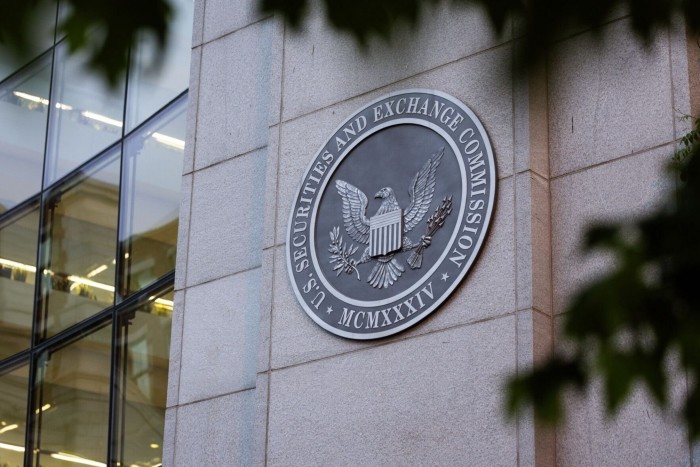
This article is an on-site version of our Moral Money newsletter. Premium subscribers can sign up here to get the newsletter delivered three times a week. Standard subscribers can upgrade to Premium here, or explore all FT newsletters.
Visit our Moral Money hub for all the latest ESG news, opinion and analysis from around the FT
Welcome back. Earlier this week, my colleague Amanda Chu looked at how regulatory uncertainty, combined with inflation and high interest rates, has held back US hydrogen projects.
For today’s newsletter, I spoke to investors about the outlook for the green fuel (notably, after the share prices of listed companies in the space have taken a beating). Major investment vehicles say they see a path forward, but opinion is split over the role that China, the dominant producer of key parts, will play.
Patrick, Gillian, Kaori, Simon and I will all be in New York City next week for Climate Week, where we’ll hope to see many of you.
Naturally, we expect the biggest news will be made at our FT Live events (you can check out the agenda here), but please let us know what else should be on our radar by replying to this email. Or if you like, reach me at [email protected]. (Lee Harris)
hydrogen
Where are the post-peak opportunities in green hydrogen?
Green hydrogen investors have been on a roller-coaster ride since 2021, when a wave of enthusiasm for the energy transition drove a run-up in stocks for the low-carbon technology. Arguments that green hydrogen could be easily swapped for fossil fuels across a range of industries drove the hype.
Since then, demand has disappointed, costs have fallen more slowly than expected, and investor enthusiasm has tumbled. The share price of HydrogenOne Capital Growth, one of the world’s largest listed investment vehicles for green hydrogen, has fallen by more than two-thirds since its peak in November 2021.
Green hydrogen optimists argue, however, that US and EU emphasis on cleaning up heavy industry and chemicals will drive growing demand for the fuel, even if it is at a lower level than the most bullish expectations. Total production capacity that has reached a final investment decision has jumped five-fold in the past 12 to 18 months, S&P Global Commodity Insights said.
Global supply of hydrogen production equipment will grow by 50 to 100 times in the next 10 to 15 years, predicted Pierre-Etienne Franc, chief executive of Hy24, a joint venture between French private equity firm Ardian and Swiss investment manager FiveT Hydrogen.
Paris-based Hy24, which raised a €2bn fund in 2022, had raised about half of a new €500mn fund for hydrogen-related equipment, Franc told me. HydrogenOne has deployed £130mn to date, also overwhelmingly in hardware.
“Now, there is an overcapacity of electrolyser manufacturing. But that’s not going to stay very long,” Franc said.
‘To avoid relocating your steel industry’, buy Chinese electrolysers
Opinion, however, is split over whether it’s best to bet on regional supply chains, or whether the industry is more likely to become economically viable by sourcing key parts from China, which has more electrolyser manufacturing capacity than the rest of the world combined. Electrolysers are the technology at the heart of a green hydrogen plant, which uses electricity to split water into hydrogen and oxygen.
Former Italian prime minister Mario Draghi’s recent competitiveness report highlighted green hydrogen’s usefulness to the energy transition — and said the high cost of electrolysers remained a significant bottleneck.
HydrogenOne’s biggest position is in Sunfire, a Germany-based electrolyser manufacturer that is also backed by Amazon, the European Investment Bank and the Liechtenstein royal family’s LGT Group.
HydrogenOne managing partner JJ Traynor told me that Sunfire’s models could overtake Chinese electrolysers, which he said “fall short” on both quality and reliability.
Traynor said Sunfire’s production of newer solid-oxide (SOEC) electrolysers made it a particularly attractive investment. He hopes these technologies can give western manufacturers an edge. SOEC technologies consume less electricity, making them more competitive when costs rise.
Franc, of Hy24, took the opposite view. Chinese electrolysers are the world’s highest quality and most affordable, he said. Indeed, he added, “if you want to avoid relocating your steel industry to China, you’d better keep it in Europe by getting access to the cheapest equipment”.
The goal, Franc said, was “to find a path where European hydrogen producers will benefit from a part of the equipment supply chain cost and quality of China, but with the right relocalisation patterns to ensure Europe continues to host its fair share of the final assembly”.
Meanwhile, Hypcap, a UK-based hydrogen private equity fund, has met electrolyser producers and is “very excited” about solid-oxide technologies, but the fund has not yet taken a stake. The space is too commoditised, chief executive James Munce argued, and for now, “the Chinese tend to be 30 to 40 per cent cheaper, and 30 to 40 per cent faster on delivery”.
“For the current fund, we’ve just said ‘look, we’re going to be procuring using today’s technology’,” he added.
China’s lead can’t be boiled down to a single technology or component, energy analyst Gniewomir Flis told me. Rather, it’s because of the nation’s early investment in the space, which has allowed it to achieve considerable knowhow.
And while it is worth exploring, Flis said, “I don’t think [solid-oxide] technology is the wunderwaffe [wonder-weapon] that western hydrogen companies need right now.” The “number-one issue” facing hydrogen, he said, is lack of long-term demand in the US and EU. China, however, has fuelled domestic demand with its low-cost electrolysers.
Munce agreed. In Europe, he said, more co-operation between industry and government was needed to create more investor certainty. “We certainly have come out of this hype cycle.” (Lee Harris)
Value-based investing
A faith-based asset manager draws SEC enforcement

While Moral Money has previously covered the Church of England and nuns who take on big companies with shareholder resolutions, we have not written about “biblically responsible investing” — until now.
On Thursday, the Securities and Exchange Commission said Inspire Investing, an asset manager that says it aims to empower Christian investors, allegedly misled its clients about its screens to identify companies with biblical values.
According to the SEC, Inspire’s exchange traded funds said they would not invest in companies that had “any degree of participation” in things such as abortion, alcohol, LGBT initiatives or tobacco, among other topics.
However, “Inspire did not typically conduct research at an individual company level to determine whether a company engaged in any of the prohibited activities”, the SEC said. “Inspire made material misrepresentations to clients and investors about how it would invest.”
The offending Inspire ETFs included $1.3bn in assets — no small amount of cash. Inspire paid a $300,000 penalty to resolve the SEC’s allegations.
In a statement, Inspire said the SEC took no issue with “the conservative, biblical values Inspire applies”, adding it was “thankful to have resolved this matter”.
As with any investment — religious or otherwise — it is essential for people to understand what they are buying, how it works and whether or not it is worth the cost.
The lesson? Don’t invest on faith alone. (Patrick Temple-West)
Smart read
Dutch bank ING will dump large clients it believes are not making sufficient progress on reducing their climate impact, Attracta Mooney reports.
Recommended newsletters for you
FT Asset Management — The inside story on the movers and shakers behind a multitrillion-dollar industry. Sign up here
Energy Source — Essential energy news, analysis and insider intelligence. Sign up here